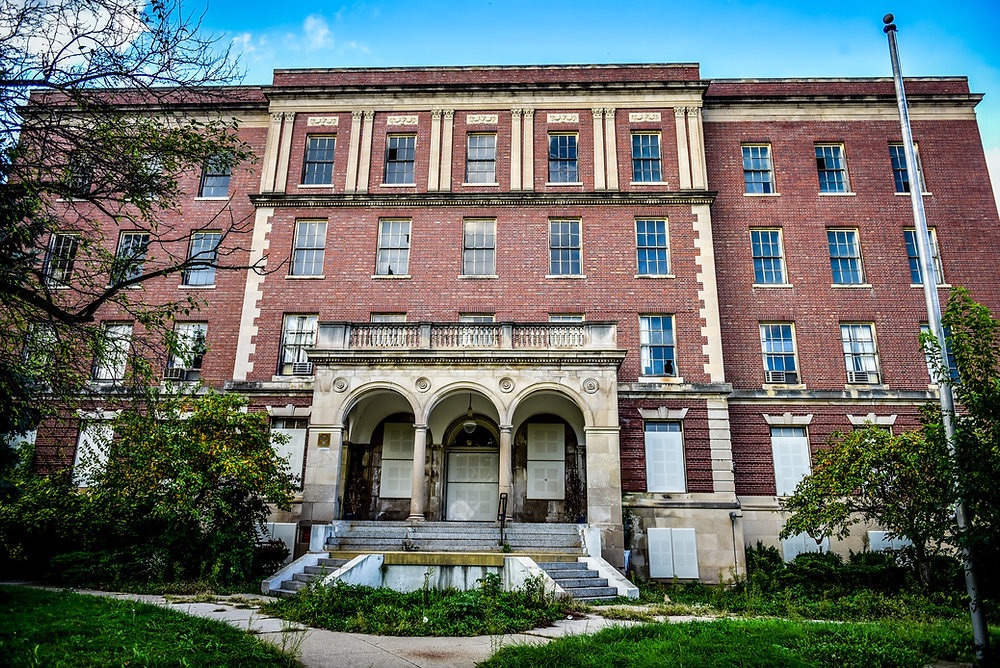Tucked away in Westland, Michigan, the Eloise Haunted Asylum, now a famous haunted attraction, has a history as dark and unnerving as its reputation. Originally part of the Eloise complex, this location once served as a psychiatric hospital and poorhouse, operating for over a century. It became one of Michigan’s most infamous institutions, and its transformation into a haunted destination only amplifies its chilling legacy.
Origins of Eloise Complex (1839–1911)
The Eloise complex began in 1839, originally known as the “Wayne County Poor House.” It was built on a modest 160-acre farm to serve the county’s impoverished population. By 1872, it had evolved into an institution for the sick, mentally ill, and homeless, gradually expanding its facilities. The complex was named Eloise in 1894 after Eloise Dickerson Davock, the daughter of the Detroit Postmaster, during an era when it housed three distinct sections: a poorhouse, a psychiatric hospital, and a general hospital.
By the early 20th century, the facility had grown to include over 900 acres and 75 buildings, serving thousands of patients. Its isolated location, combined with its massive size, made it a self-sustaining community with its own bakery, laundry, post office, and even a fire department. However, behind its sprawling infrastructure, a much darker reality existed.
Expansion and Decline (1911–1950s)
As the years went by, Eloise Asylum became synonymous with mental health care and treatment of the time. By the 1930s and 1940s, it was home to over 10,000 patients and employed more than 2,000 workers. It operated as one of the largest psychiatric facilities in the United States, specializing in the treatment of mental illness and tuberculosis, which was rampant during the early 20th century.
During this period, the institution utilized treatments now considered archaic and cruel, including electroshock therapy, lobotomies, hydrotherapy, and various forms of physical restraints. Many patients admitted to the asylum were subjected to these invasive procedures with little understanding of mental health, leaving a lasting impact on the individuals treated. The hospital’s reputation became increasingly infamous for the overcrowded conditions, lack of proper care, and abuse allegations. Many patients were simply warehoused, left to spend their lives in isolated wards or forgotten in padded cells.
Some reports suggest that during this time, unmarked graves were used for patients who passed away, and many believe the spirits of those who were neglected or mistreated still linger within the buildings’ walls.
The Closing of Eloise (1960s–1982)
By the mid-20th century, the public perception of mental health treatment began to change, and large-scale institutions like Eloise fell out of favor. Advances in psychiatric care, along with an emphasis on outpatient treatment and deinstitutionalization, caused patient populations to dwindle. Eloise’s massive campus began to close down its operations, with many buildings falling into disrepair.
In 1979, the last psychiatric ward was shuttered, and by 1982, the complex was officially closed. Most of the original structures were demolished, but a few iconic buildings remain, such as the Kay Beard Building, where paranormal investigators have reported numerous sightings of ghostly apparitions, unexplained sounds, and other eerie phenomena. Over time, the abandoned halls of Eloise became a hotbed for urban explorers, ghost hunters, and those curious about the supernatural.
Eloise Haunted Asylum: The Attraction
Today, Eloise Haunted Asylum operates as a haunted house attraction, blending its harrowing past with horror-filled entertainment. Its reputation as one of Michigan’s premier haunted houses is bolstered by the location’s authentic history and the eerie atmosphere that still pervades its remaining buildings. Visitors are invited to experience the terror for themselves, with the attraction incorporating elements from its haunted past, such as the historic psychiatric treatments and the facility’s unsettling reputation.
Each October, the asylum transforms into a multi-level scare experience featuring live actors, high-tech effects, and interactive horror scenes that take guests through the very halls where patients once roamed. The attraction also honors Eloise’s history with exhibits and paranormal investigations, giving thrill-seekers and history buffs alike a glimpse into the building’s tragic and spooky past.
The popularity of Eloise Haunted Asylum has drawn attention from paranormal researchers and enthusiasts, with claims of ghost sightings, unexplained noises, and sudden temperature drops within the buildings. Some staff and visitors have reported strange occurrences, such as shadow figures, disembodied voices, and feelings of being watched.
Paranormal Investigations and Pop Culture
Over the years, Eloise Haunted Asylum has gained notoriety as one of Michigan’s most haunted locations. It has been featured in numerous paranormal investigation shows, documentaries, and news articles. Paranormal enthusiasts believe the asylum is still home to many of its former residents’ spirits, including those who suffered under the harsh conditions of the psychiatric hospital.
Paranormal investigators often report witnessing shadowy figures moving through the halls, hearing unexplained footsteps, and experiencing cold spots. Some claim that certain areas of the building seem to be more active than others, particularly the old psychiatric wards where treatments like electroshock therapy and hydrotherapy were most prevalent.
The hauntings at Eloise have earned it a place in Michigan’s ghost lore, and it’s not uncommon to hear new stories every year of people encountering eerie presences or capturing strange phenomena on camera.
Conclusion: A Haunted Legacy
Eloise Haunted Asylum’s transformation from a psychiatric hospital into a premier haunted attraction is a testament to its lasting impact on Michigan’s history. What began as a place of refuge for the poor and mentally ill has become a source of both fear and fascination. Today, Eloise stands as a reminder of how mental health care has evolved and the dark history that lingers in places once forgotten. For visitors, the haunted asylum offers not only spine-tingling scares but also a sobering reflection on its tragic past.
Those who enter its eerie halls can’t help but wonder: Is it just an attraction, or is something still lurking in the shadows?

